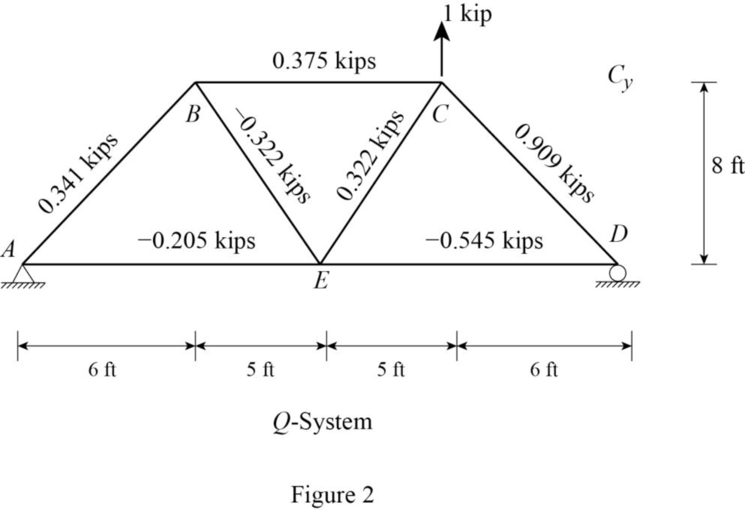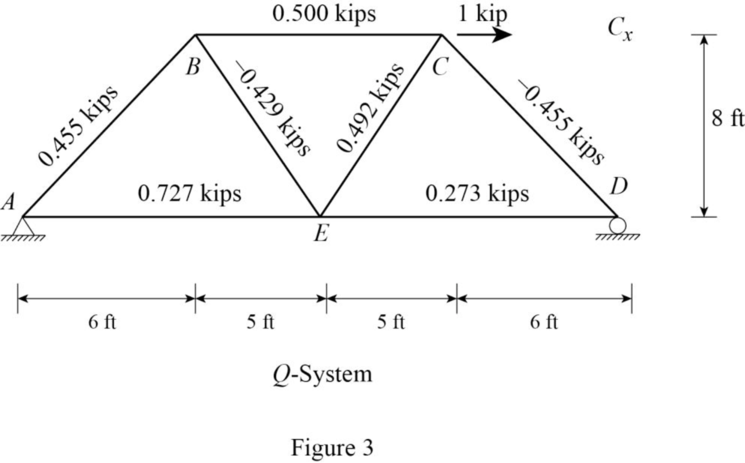
(a)
Find the vertical displacement of joint C.
(a)
Answer to Problem 4P
The vertical deflection at joint C
Explanation of Solution
Given information:
Area of members AB, BC, and CD are
The value of E is
Procedure to find the deflection of truss by virtual work method is shown below.
For Real system: If the deflection of truss is determined by the external loads, then apply method of joints or method of sections to find the real axial forces (F) in all the members of the truss.
For virtual system: Remove all given real loads, apply a unit load at the joint where is deflection is required and also in the direction of desired deflection. Use method of joints or method of sections to find the virtual axial forces
Finally use the desired deflection equation.
Apply the sign conventions for calculating reactions, forces and moments using the three equations of equilibrium as shown below.
For summation of forces along x-direction is equal to zero
For summation of forces along y-direction is equal to zero
For summation of moment about a point is equal to zero
Method of joints:
The negative value of force in any member indicates compression (C) and the positive value of force in any member indicates tension (T).
Condition for zero force members:
If only two non-collinear members are connected to a joint that has no external loads or reactions applied to it, then the force in both the members is zero.
If three members, two of which are collinear are connected to a joint that has no external loads or reactions applied to it, then the force in non-collinear member is zero.
Calculation:
Find the bar forces
Let
Let
Find the reactions at the supports using equilibrium equations:
Summation of moments about A is equal to 0.
Summation of forces along y-direction is equal to 0.
Summation of forces along x-direction is equal to 0.
Find the member forces using method of joints:
Apply equilibrium equation to the joint A:
Apply equilibrium equation to the joint D:
Apply equilibrium equation to the joint B:
Apply equilibrium equation to the joint C:
Sketch the bar forces produced by the P-system as shown in Figure 1.

Consider a dummy load of 1 kN directed vertically at joint C with the bar forces
Find the reactions at the supports using equilibrium equations:
Summation of moments about A is equal to 0.
Summation of forces along y-direction is equal to 0.
Summation of forces along x-direction is equal to 0.
Find the member forces using method of joints:
Apply equilibrium equation to the joint A:
Apply equilibrium equation to the joint D:
Apply equilibrium equation to the joint B:
Apply equilibrium equation to the joint C:
Sketch the bar forces

Refer Table 1 for vertical displacement of joint C.
(b)
Find the horizontal displacement of joint C.
(b)
Answer to Problem 4P
The horizontal deflection at joint C
Explanation of Solution
Given information:
Area of members AB, BC, and CD are
Calculation:
Consider a dummy load of 1 kN directed horizontally at joint C with the bar forces
Find the reactions at the supports using equilibrium equations:
Summation of moments about A is equal to 0.
Summation of forces along y-direction is equal to 0.
Summation of forces along x-direction is equal to 0.
Find the member forces using method of joints:
Apply equilibrium equation to the joint A:
Apply equilibrium equation to the joint D:
Apply equilibrium equation to the joint B:
Apply equilibrium equation to the joint C:
Sketch the bar forces

Refer Table 1 for horizontal displacement of joint C.
(c)
Find the horizontal displacement of joint D.
(c)
Answer to Problem 4P
The horizontal deflection at joint D
Explanation of Solution
Given information:
Area of members AB, BC, and CD are
Calculation:
Consider a dummy load of 1 kN directed horizontally at joint D with the bar forces
Find the reactions at the supports using equilibrium equations:
Summation of moments about A is equal to 0.
Summation of forces along y-direction is equal to 0.
Summation of forces along x-direction is equal to 0.
Find the member forces using method of joints:
Apply equilibrium equation to the joint A:
Apply equilibrium equation to the joint D:
The force in the member AB, BE, EC, BC, and CD are zero as it satisfies zero force member condition.
Sketch the bar forces

Find the vertical deflection at joint C
Find the horizontal deflection at joint C
Find the product of
| Bar |
A |
L | ||||||||
| AB | 1 | 10 | 0.455 | 0.341 | 0 | 0 | ||||
| BC | 1 | 10 | 0.500 | 0.375 | 0 | 0 | ||||
| CD | 1 | 10 | 0.909 | 0 | 0.026 | 0 | ||||
| DE | 0.25 | 11 | 2.898 | 0.273 | 1 | 0.042 | 0.153 | |||
| EA | 0.25 | 11 | 0.727 | 1 | 0.018 | |||||
| EB | 0.25 | 9 | 13.133 | 0 | 0 | |||||
| EC | 0.25 | 9 | 4.556 | 0.429 | 0 | 0.066 | 0 | |||
Refer Table 1.
The vertical deflection at joint C
The horizontal deflection at joint C
The horizontal deflection at joint D
Want to see more full solutions like this?
Chapter 8 Solutions
FUND. OF STRUCTURAL ANALYSIS-W/ACCESS

 Structural Analysis (10th Edition)Civil EngineeringISBN:9780134610672Author:Russell C. HibbelerPublisher:PEARSON
Structural Analysis (10th Edition)Civil EngineeringISBN:9780134610672Author:Russell C. HibbelerPublisher:PEARSON Principles of Foundation Engineering (MindTap Cou...Civil EngineeringISBN:9781337705028Author:Braja M. Das, Nagaratnam SivakuganPublisher:Cengage Learning
Principles of Foundation Engineering (MindTap Cou...Civil EngineeringISBN:9781337705028Author:Braja M. Das, Nagaratnam SivakuganPublisher:Cengage Learning Fundamentals of Structural AnalysisCivil EngineeringISBN:9780073398006Author:Kenneth M. Leet Emeritus, Chia-Ming Uang, Joel LanningPublisher:McGraw-Hill Education
Fundamentals of Structural AnalysisCivil EngineeringISBN:9780073398006Author:Kenneth M. Leet Emeritus, Chia-Ming Uang, Joel LanningPublisher:McGraw-Hill Education
 Traffic and Highway EngineeringCivil EngineeringISBN:9781305156241Author:Garber, Nicholas J.Publisher:Cengage Learning
Traffic and Highway EngineeringCivil EngineeringISBN:9781305156241Author:Garber, Nicholas J.Publisher:Cengage Learning





